From my research, I have created an art series, which includes twenty-three drawings based on the original mug shots from the police files. I printed each one of these on a particular type of art paper lightening and darkening certain areas. I then used graphite to draw the faces of each portrait. I combined the graphite with the ink in bringing out the detail and the personality of each subject, as well as giving the drawing a three-dimensional appearance. The face of each of the subjects compelled me to capture the individual’s character, which they were and what they were about at this particular time when their mugshot was taken. My unique talent is to bring energy of “aliveness” to the artwork. When you look into their eyes you sense a real person is looking back at you, and you wonder who they were and what they were thinking at the time of their arrest. Each drawing represents approximately eighty hours of effort. There is more information about the history of Omaha at this time and excerpts on some of the people in the mugshots from my research. One of the mugshots turned out to be an infamous bandit from the area, Pat Crowe. I have a summary of his exploits under his name.
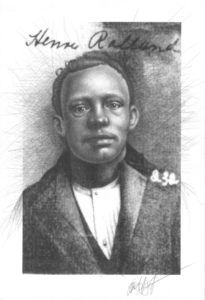
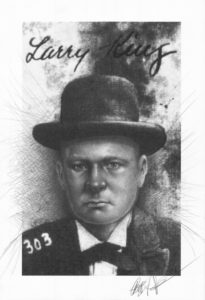
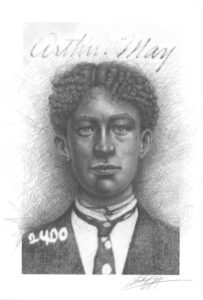
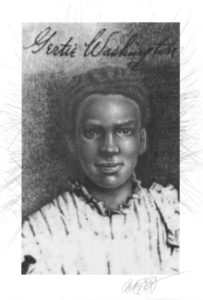
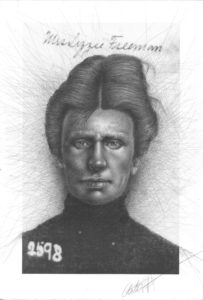
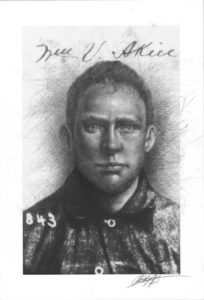

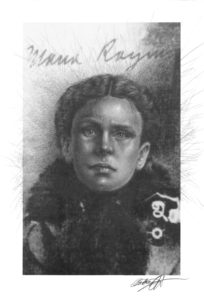
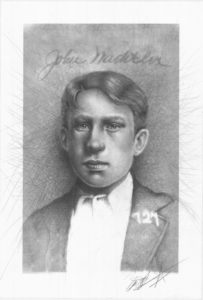
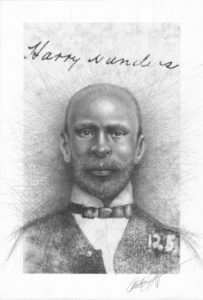
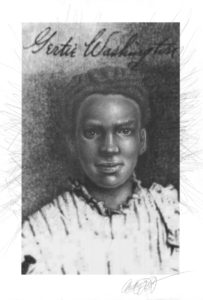
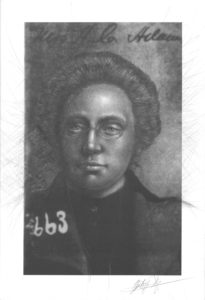
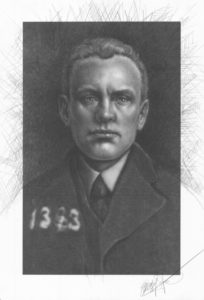

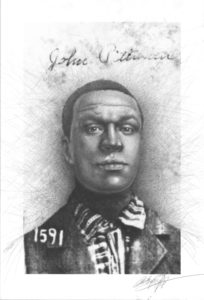
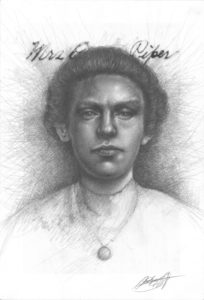

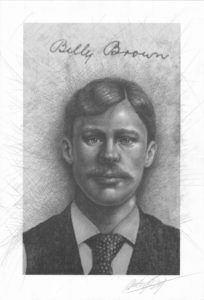
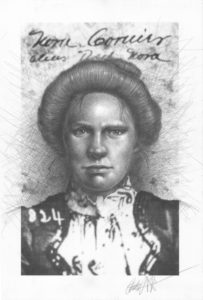
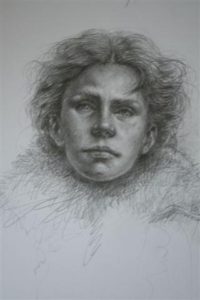
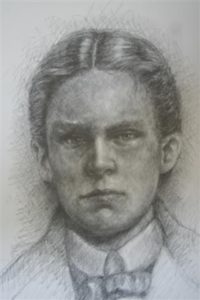
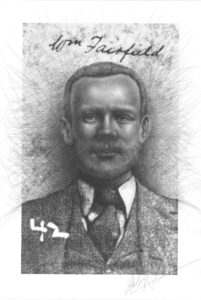
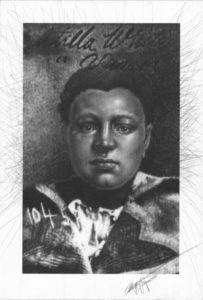
“Arthur May, Bell Hop, forcefully broke in and entered Julius J. Petersen’s office door unlawfully and intended to steal goods and things. He took and carried away: ten and one half pennyweight of gold scrap: one tenth of an ounce of gold filling: two gold brides: four Spanish coins and stolen goods that came to twenty-five dollars and seventy cents. Sol Brodkey was one of the witnesses called upon at this time and became quite well known for his jewelry store through the 1900’s.
On October 4, 1910, Arthur May was tried, convicted, and sentenced. He was transported by Braidly, the sheriff, to the Nebraska State penitentiary in Lancaster, NE. His institution number was 5523. He served one and half years and was released on November 26, 1911.”
“One morning early last September the body of Edward Fee was found in the rear of a blacksmith shop in the vicinity of Twenty-fifth and Cumming streets. The head cut, bruised and battered. It was ascertained that Fee, Coyne, Floth and Mollner had been seen together during the previous evening. At the police station they confessed to the commission of the murder.”
FLOTH
“Floth admits that at this time he jumped in and struck Fee several times while the others were kicking. After discovering that Fee was unconscious, the three men left and when they got a few feet away, they turned and noticed that he was staggering to his feet. Floth then returned, knocked Fee down and rifled his pockets, taking his knife and a silver watch. The knife was thrown away and the watch was hidden in the weeds at St. Mary’s Avenue and Twenty-fifth street, where it was found this afternoon. Floth designating the place where it was located.”
The physician who made the post mortem examination testified that the death of Fee was caused by a kick on the right side of the head and not by any of the fist blows that had been dealt to the face. The evidence of all the state’s witnesses was that Coyne struck Fee with his fist but did not kick him and that the kicking was done by Harry Floth.
Judge Baker was unwilling to let the jury decide the case by inference, as it would have to do in the absence of facts.”
WACHTER
“It is the theory of the police that Fee was set upon and beaten to death because he refused to buy a can of beer for the crowd. The main witness which the prosecution relies on to prove it’s case is John Wachter, who, it is said, was a member of the gang which killed Fee, and will turn state’s evidence.
During the “sweating” process applied to Harry Floth, Leo Coyne and Milk Mollner all admitted that there was another party present at the time of the murder. This party was John Wachter, employed at Hammond’s packing house in South Omaha. None of the young men is past 22 years old, Wachter is 19.”
COYNE
“There was some conversation, during which Floth insisted upon Fee buying a pail of beer. This he refused to do, saying that he had no money. He was accused of being a deadbeat and resenting this with an oath, Coyne struck him in the face, knocking him down.”
The state’s case against Leo Coyne, who has been on trial in Judge Baker’s court for the murder of Edward Fee, has collapsed. Judge Baker this afternoon instructed the jury to return a verdict of not guilty.”
Maude was accused of stealing a $22.50 fur collar at John Urbanczyk’s furrier of 320 South 15th Street. Judge Slabaugh decided there was enough evidence that Maude should be held in jail. Judge Gordon later set her bail at $1000. Judge Gordon stated in naming this amount that he would make the “bond large enough to cover any other charges which might be filed against the woman, as he understood she would be held upon one more serious than merely that of being a suspicious character”. (shop lifting) Attorney Walker pleaded habeas corpus and a whole circle of events took place. Eventually the judge was held in contempt, and police officers were accused of false arrest. Maude was released finally on a $200 bond and ended up spending 30 days in jail for stealing a fur collar that was never found and no proof. Habeas corpus is a legal action, or writ, through which a person can seek relief from the unlawful detention of him or herself, or of another person. It protects the individual from harming him or herself, or from being harmed by the judicial system. Maude was 24, listed as a prostitute, 5’4”, 103 lbs.,complexion:M,chestnut hair, green blue eyes, arrested December 22, 1897, for shoplifting. It was also noted that her little fingers were bent inward.
Mrs. Anna Piper
Mrs. Anna Pipers mug writeup, 1911, said she was a prostitute as an occupation and crime was fugitive. There wasn’t any other information except for her divorce in 1914. One can only imagine the events that led up to this.
“Said defendant, regardless of her marital duties as a wife, and without provocation on the part of said plaintiff, has on sundry and diverse occasions been guilty of extreme cruel and inhuman treatment until she has destroyed the peace of the domestic relation and this plaintiff’s happiness and comfort. Plaintiff has always been willing to allow this defendant to return to his bed and board, but that this defendant has and does refuse so to do.” 1914
PAT CROWE
This is just a brief summary of Crowe’s exploits. I have much more information in detail that I researched. His exploits read like a fiction novel. He was not a mean man and became a Robin Hood of the times for the common person. His personality was fearless, humorous and caring, and later on in life he hung out with celebrities and wrote a book about his life. There is also another published book about his life. He was as infamous as Jesse James, but many do not know about him.
I have enough information to make a screen play. If interested in more information contact me.
Pat Crowe was a criminal with a moral code and larger than life personality
You just want to love this guy. He’s sarcastic, witty and totally irreverent towards authority and speaks his mind.
Fearless in the face of death.
Mother blinded when he was born.
He had 3 children that died in childhood.
The Meat Mogul, Edward Cudahy undercut his prices as a butcher
He kidnapped Cudahy’s son for revenge.
He went to his house beforehand to case it. Cudahy even offered him a good job. When Cudahy’s son was asked what it was like to be kidnapped, he said “He let me smoke cigarettes the whole time”. When Crowe received the ransom money he let the boy go home, unharmed.
He was acquitted and cheered. He became the defender of justice.
Fascinating letter of arrogance sent to police demanding certain stipulations if he would turn himself in. Priceless!!.
He even wrote Cudahy’s son when he got married, congratulating him for getting a new kidnapper, signing it his ex kidnapper.
He was In jail one time because of some altercation. He ended up holding the jail up as hostage, while outing the sheriff.
Crowe ended up with a 6 month sentence after getting a U.S. Senator to take his case.
Another time Bat Masterson got him off charges.
He had a love relationship with Myrtle Harris, the sister of a jail mate.
Tortured to a point of coma in jail. The Warden didn’t like him because of his arrogance.. He was not submissive!
Four kids were killed trying to rob a train to get money to get their brother out of jail who stole something minimal to survive, because they were poor. He robbed the same train successfully thumbing his nose at the law.
Once he saved a Sheriff he and his gang had tied up in order to blow a safe. He ran back, grabbing the man in the chair jumping out the window.
He planned on robbing P.T. Barnums wife of $40,000 in jewelry.
He had many alias’s and changed his looks and hair color. He also would dress up like a woman and pretend he was a priest, to cover his tracks.
Crowe hung out with celebrities and was defended by well known lawyers and politicians.
He was invincible, many thought, considering the gun battles he was in, bullets flying everywhere but he would come out unscathed.
Crowds cheered him and also wanted to lynch him.
In his years of reform he wrote 2 books, talked at circus’s, lectured the circuit and attempted to initiate things to rehabilitate youth and the prison system.
He died an alcoholic in a flop house.
HISTORY OF OMAHA AT THE TIME
The mug shots were captured by the police in Omaha. The Police Department started taking photographs of people around 1890 and kept by the Historical Society at Fort Crook.
For me there is a fascination with that one moment in time where the mugshot was taken. Some of the crimes were simply “Suspicious Character” or arrested under “General Principal”. Prostitution was not listed as a crime but an occupation. In researching the people I did I find an infamous bandit along with amusing characters and darker subjects of violence. My intent was to bring the personality alive again, for one more “moment in time” in my detailed graphite drawings.
To give you an idea of the backdrop of this time period from the 1870’s to 1910, I have included some excerpts of history.
OMAHA
This was a famous poem depicting Omaha in an article from Harpers Magazine, September 1869
Hast ever been in Omaha,
Where rolls the dark Missouri down,
And four strong horses scarce can draw
An empty wagon through the town?
Where sand is blown from every mound
To fill the eyes and ears and throat-
Where all the steamers are aground
And all the shanties are afloat?
Where whisky shops the livelong night
Are vending their poison juice:
Where men are often very tight,
And women deemed a trifle loose?
Where taverns have an anxious guest
For every corner, shelf and crack;
With half the people going west,
And all the others going back?
Where theaters are all the run
And bloody scalpers come to trade;
Where everything is overdone
And everybody underpaid?
If not, take heed to what I say:
You’ll find it just as I have found it;
And if it lies upon your way,
For God’s sake, reader, go around it!
The site of Omaha was first known as “Lone Tree Ferry”, where, for several years, W.D. Brown ran a flat-boat across the river with California emigrants; the place was an old camping ground.
The name Omaha came from an Indian word/phrase (E-ro-ma-ha), translated as “above all others upon the stream”.
While Native American culture dates back considerably further, Lewis & Clark first explored this area in 1804. On July 21, 1804, Lewis & Clark passed the area that would become the city of Omaha and noted that it would be a good location for a trading establishment and military fortification.
In Nebraska,up until 1881 physicians were not required to register with the county clerks or show credentials. Medicine was largely unregulated. It was legal to make false claims and to deceive the consumer as to it’s actual ingredients. No research or patents were necessary. Most of the drugs were harmless, even though they did contain high doses of narcotics and alcohol, and were given to children at this time. Some of the “ingredients” were cocaine and opium, of which heroin was also used.
The trial of Standing Bear, a Ponca Indian chief, in a United States District court in Omaha in l879, led to a decision by Judge Elmer Dundy that native Americans are “persons within the meaning of the law” and have the rights of citizenship.
A sewer system was not fully developed until 1895 and it was not until 1945 that outhouses and cesspools were outlawed. Garbage was thrown out into the streets. Hogs were the original garbage collectors.
Immigration in Omaha peaked in the 1870’s and by 1880 accounted for over 1/3 of Omaha’s population, and by 1900 it was half. English (Omaha’s Barker Building, Joseph Barker), Czech (founders of Sokol Hall, newspaper “Free thinker”) Irish (Creighton/banker, college, telegraph), German (Furriers and newspaper),Swedish (Swanson Foods) are some of the ethnic groups moving to Omaha.
“In 1855, the council chamber of the first territorial capitol building, 9th and Farnam, served as the sanctuary for three congregations: Methodists met in the morning,Congregationalists in the afternoon and the Baptists in the evening. They all joined in a union Sunday School.
The brick building had two floors, plus a basement with a dirt floor. the capitol building had no outdoor privy, so the dirt-floor of the basement was used as the toilet by the legislators and the church members. No privacy.
A summer day with little breeze made the upper floors exceedingly unpleasant.
(28-41) Omaha: The Prairie Blossoms
A teenager, Clement C. Chase, founded the chief society paper called the Excelsior for Omaha’s elite.
The Trans-Mississippi and International Exposition of 1898 was organized to prove that Omaha was the gateway city to the West and to demonstrate the region’s victory over the hard times of the 1890’s. This world’s fair was visited by over 2 million people. It included livestock shows, museum, trade shows, carny midway and was a high point of Omaha history. It brought Geronimo and president McKinley to Omaha.
By 1890”s South Omaha boasted the third largest meat packing center in the country, where over 4,000 employees processed two million animals each year.
Railroads came to Omaha at a crucial time. They opened new markets for merchants, new farmland for settlers, new profits for investors and new jobs for everyone. When the Union Pacific’s bridge spanned the Missouri River in 1872, Omaha was firmly linked to eastern markets and a promise of prosperity. In 1866 the first Union Pacific depot, Burlington, architect Thomas Kimball, and Missouri river station of 1896 and the U.P. terminal in 1900. For $20 a person could ride from New York to Omaha.
Slavery was not outlawed in Nebraska until 1861. J. Sterling Morton from Nebraska City , U. S. secretary of agriculture was pro-slavery.3Andrew J. Hanscom, a lawyer and real estate owner and known for Hanscom park, was anti-slavery.
CRIME
It wasn’t until around 1870’s that a legal system for handling crime came to Omaha. In 1869 there was one captain, one lieutenant and 18 patrolmen. Salaries were $90 a month for the captain and the lieutenant and $70 a month for the patrolmen.
The legal system was very antiquated, starting out with Marshals, Sheriffs and Rangers to create peace. They were called peace officers.
There was also the “Claims Club”. The club was effective in protecting its members’ claims, primarily and frequently using mob violence to enforce its rule. The club’s vigilantes rode masked and at night, frustrating efforts to identify the mob. The Omaha Claim Club became recognized as the unofficial court governing land claims, and in 1854 Alfred D. Jones, a surveyor, divided land into blocks starting by the ferry landing. That was the first time anyone planned what Omaha would look like. Jones was soon afterwards appointed the first postmaster of Omaha. Later Club leadership included Andrew J. Poppleton.
Alexander Baker V. William Morton became a precedent in cases of contractual holdup to establish the illegal nature of the Omaha Claim Club’s activities and other activities that reflect this form of collusion. this was in 1871
The club often met where the Gene Leahy Mall is located.
The first murder in douglas County was by a physician, in a land dispute. He was appreciated and needed in the community. Two juries were called, but neither would convict
POLICE were equipped with only nightsticks and whistles. Assaults and robberies were more common than murder.
In 1885 arrests were difficult because the officer had to drag his prisoner a mile or so to the nearest telephone to notify the station. The station notified the stables and the driver would fetch the prisoner to the station. the telephone had only been invented about 10 years previously
PROSTITUTION AND WOMEN’S RIGHTS
A 1918 health commissioner’s report said that at least 1600 women were working the “vice-trade”. It was estimated that men who lived in Omaha for ten years or more, 50% “have or have had, social (i.e. sexually transmitted) diseases.
“The Christian world is delighted to have a MAN who has been a drunkard, and burdened with all of the sins which go with that condition, reform. he is encouraged, invited into business circle,
into the home, into the church, upon the platform, and into public life. He is not obliged to hide behind false colors.
But the prostitute who wishes to reform is shown no such grace. Either she accepts the brand of “RESCUED’ – and the snubs, the mistrust, and the condescension attached to the label – or she hides her past, creates yet another false identity, and prays that she is never found out.”
Josie Washburn-”The Underworld Sewer”
In Omaha’s vice district referred to as the “Burnt District” was a place known as “the Cribs”. This is where young girls from 11 to 30 were involved in Prostitution with the full knowledge of Victorian-era Omaha for over 20 years. It extended from Douglas Street. 6 blocks north to Cass and from the river west to 16th. The cribs were in the alleyways and consisted of 2 small rooms about 6 feet high; a door and a window forms the whole front. Each crib has a projecting corner, so that looking down the line you get a scalloped appearance, which is meant to be artistic. The alleys are paved regardless of expense and have heavy iron gates at each end. The alleys are covered by a fancy roof and strings of electric lights. The shades are never drawn and what transpires within is clearly seen from the outside. Young boys of al ages are allowed to visit the district and take their first steps into vice.
Information from Josie Washburn and a grand jury report 1907
The fight for woman’s right to vote in the United States is one of the most under-appreciated civil rights movements in history: a seventy-two year long struggle whose methods of nonviolent protest predated many of the more well-known movements of the 20th century.
In the early 1800s, women were second-class citizens. Women were expected to restrict their sphere of interest to the home and the family. Women were not encouraged to obtain a real education or pursue a professional career. After marriage, women did not have the right to own their own property, keep their own wages, or sign a contract. In addition, all women were denied the right to vote. Only after decades of intense political activity did women eventually win the right to vote.
In the 1800s, women in the United States had few legal rights and did not have the right to vote. This speech was given by Susan B. Anthony after her arrest for casting an illegal vote in the presidential election of 1872. She was tried and then fined $100 but refused to pay.
Friends and fellow citizens: I stand before you tonight under indictment for the alleged crime of having voted at the last presidential election, without having a
lawful right to vote. It shall be my work this evening to prove to you that in thus voting, I not only committed no crime, but, instead, simply exercised my citizen’s rights, guaranteed to me and all United States citizens by the National Constitution, beyond the power of any state to deny.
The preamble of the Federal Constitution says:
“We, the people of the United States, in order to form a more perfect union, establish justice, insure domestic tranquillity, provide for the common defense, promote the general welfare, and secure the blessings of liberty to ourselves and our posterity, do ordain and establish this Constitution for the United States of America.”
It was we, the people; not we, the white male citizens; nor yet we, the male citizens; but we, the whole people, who formed the Union. And we formed it, not to give the blessings of liberty, but to secure them; not to the half of ourselves and the half of our posterity, but to the whole people – women as well as men. And it is a downright mockery to talk to women of their enjoyment of the blessings of liberty while they are denied the use of the only means of securing them provided by this democratic-republican government – the ballot.
For any state to make sex a qualification that must ever result in the disfranchisement of one entire half of the people, is to pass a bill of attainder, or, an ex post facto law, and is therefore a violation of the supreme law of the land. By it the blessings of liberty are forever withheld from women and their female posterity.
To them this government has no just powers derived from the consent of the governed. To them this government is not a democracy. It is not a republic. It is an odious aristocracy; a hateful oligarchy of sex; the most hateful aristocracy ever established on the face of the globe; an oligarchy of wealth, where the rich govern the poor. An oligarchy of learning, where the educated govern the ignorant, or even an oligarchy of race, where the Saxon rules the African, might be endured; but this oligarchy of sex, which makes father, brothers, husband, sons, the oligarchs over the mother and sisters, the wife and daughters, of every household – which ordains all men sovereigns, all women subjects, carries dissension, discord, and rebellion into every home of the nation.
Webster, Worcester, and Bouvier all define a citizen to be a person in the United States, entitled to vote and hold office.
The only question left to be settled now is: Are women persons? And I hardly believe any of our opponents will have the hardihood to say they are not. Being persons, then, women are citizens; and no state has a right to make any law, or to enforce any old law, that shall abridge their privileges or immunities. Hence, every discrimination against women in the constitutions and laws of the several states is today null and void, precisely as is every one against Negroes.
Susan B. Anthony – 1873
HISTORY IN THE MAKING
Karl Benz builds the world’s first gasoline-powered vehicle. It has a traveling speed of nine miles per hour. 1886
Louis Pasteur administers the first anti-rabies vaccine to a nine-year-old schoolboy. Although medical professionals treat the vaccine with suspicion at first, it soon catches on.
The first modern bicycle is built. Bikes are a craze in America and Europe until the end of the century.
Trains ran at 25 miles an hour. Steamers ran at 10 miles per hour.
A favorite Christian hymn, “Amazing Grace”, was written by John Newton, who was converted to a new understanding on a slave ship and ordered the ship to turn around. “I once was blind, but now I see”.
Needing a game to keep students busy between the baseball and football seasons, gym teacher James Naisfeld invents basketball in Springfield, Massachusetts.
The first Coca-Cola is sold in Atlanta, advertised as a hangover remedy containing coca leaves and African kola nut extract.
Impressionism has its final show at the Maison Doree in Paris. Sculptor Auguste Rodin finishes The Kiss, a work based on a tale by medieval poet Dante Alighieri.
The last large-scale Indian war in the United States ends when American troops capture Apache chief Geronimo after four years of warfare on the Mexican border.
Catering to farmers far from large stores, Richard Sears establishes a successful mail-order house in Minneapolis, first selling watches. He hires A.C. Roebuck as a watch repairman the next year in Chicago.
Thomas Edison invents the record player.
Auguste Rodin finishes his sculpture The Thinker.
George Eastman invents the Kodak camera, making it possible for anyone, not just professionals, to take photographs.
The Eiffel Tower is completed in Paris.1889
Electric lights are installed at the White House, but President Benjamin Harrison and his wife refuse to touch the switches, so the lights are turned on by an employee at night, then turned off in the morning. 1889
In a frenzy of activity, Vincent Van Gogh finishes several famous paintings, including The Starry Night, one of his last works.
Emily Dickinson’s first volume of poetry is published posthumously.
The Ohio Supreme Court outlaws John D. Rockefeller’s Standard Oil Trust under the Sherman Anti-Trust Act. But Rockefeller simply re-incorporates in New Jersey, where corporations are allowed to hold other companies, and keeps his company under the new name Standard Oil of New Jersey
Peter Ilyich Tchaikovsky conducts part of the first concert in brand-new Carnegie Hall.